The Ultimate Guide to Purchasing a Ductless Mini-Split Air Conditioner System
-
 By
Michael Haines
By
Michael Haines
- May 6, 2020
Ultimate Guide to Purchasing a Ductless Mini-Split Air Conditioner System
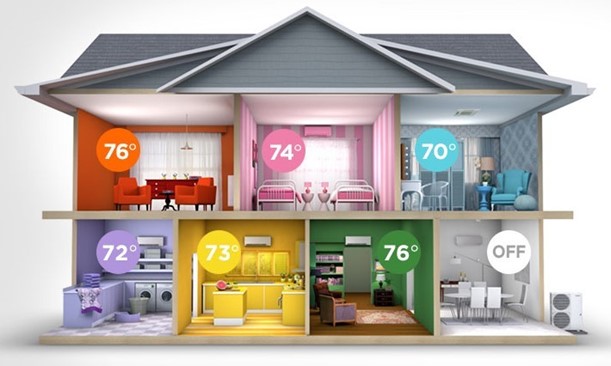
Edited and updated by Michael Haines, a 30-year HVAC veteran on 10/30/23
Michael Haines here, bringing you an indispensable ductless mini-split system guide. Mini-split systems are gaining traction quickly as a versatile solution for setting the ideal climate in various rooms. Brands are abundant, flaunting unique features, warranty options, and pricing tiers. This guide aims to break down the specifics for you.
Mini-splits go by a jumble of names—Ductless AC, Air Conditioner Mini, Mini Split AC, and even the fancy-sounding Mitsubishi Mr. Slim. Why the name chaos? Well, manufacturers are racing to stand out before "ductless mini-split" becomes as generic as Kleenex or Band-Aid. You may have stumbled upon this guide via Google or perhaps a home improvement site pointed you here. Either way, rest assured you've landed where you need to be.
Why are you considering a ductless system, you ask? You may add a new room to your home, revamp your office, or transform a warehouse space. The "why" might differ, but the "what" remains the same— a ductless system offers a versatile, efficient solution for your climate control needs.
So, are you ready to become so well-versed in ductless mini-splits that you can't help but chat about them at social gatherings? Keep reading to cover everything from the ins and outs of how these systems work, their pros and cons, and how to score one at a good price. We'll also evaluate popular brands to help you sift through the clutter. All set? Let's get into it.
Click here to view near wholesale pricing on ductless mini split air conditioners or call:
- Quick Overview of What We’re Covering
- Overall Brand Comparisons for Mini Split Systems
- Let’s Compare the Goodman and Daikin Brands
- Since We Are Here, Let’s Compare 4-zone Mini Split Systems
- Air Con 36000 BTU
- Daikin 4 Zone Mini Split AC Heat Pump
- GREE 42000 BTU 4 Zone Ductless Heat Pump Mini Split AC System
- Mitsubishi 36000 BTU Smart 4 Zone Ductless Heat Pump Mini Split AC System
- MrCool Customizable 4 Zone 36000 BTU 4th Gen DIY Heat Pump Mini Split AC System
- When is a mini-split AC NOT the best option?
- When is a ductless mini-split a good idea?
- What is Ductless Mini-Split Inverter Technology?
- Ductless Mini-split Inverter Technology benefits
- Everything you’ve ever Wanted to Ask about Mini-Split AC Units
- What is a ductless mini split?
- Mini split noise level – What is the quietest mini-split system?
- How much does it cost to buy and install a ductless mini-split?
- Is a ductless heat pump AC system more energy efficient?
- How do ductless air conditioners work?
- Are there different types of ductless AC indoor units?
- High Wall mounted –
- Low sidewall (floor mounted) –
- Ceiling recessed –
- Horizontal Ducted attic mount –
- Do I need a mini split for every room?
- How many ductless units do I need?
- Does a mini split cool the whole house?
- Can ductless AC cool multiple rooms?
- How many BTU’s do I need? (Cooling and heating)
- Does a ductless mini split heat well in cold climates?
- Ductless Mini Split AC Systems: The Heating and Cooling Wave of the Future
- To Wrap it Up
Overall Brand Comparisons for Mini Split Systems

Brands of Mini Split Systems and What You Need to Know
When choosing a mini-split air conditioning system, several factors include brand recognition, energy efficiency, features, warranty, price, and the potential for DIY installation. Below is a look at popular brands of mini split systems and a detailed comparison of the various brands based on these criteria.
Mitsubishi & Mitsubishi Electric Mini Split
Mitsubishi is synonymous with quality and reliability in the mini-split market. They are acknowledged as a leader in the sector, largely due to entering the market earlier than most competitors. Their units are highly reviewed and provide solid value for the investment. Mitsubishi Electric, a subset of Mitsubishi, focuses on residential and commercial applications.
The brand is notable for using inverter-driven compressors, which significantly improve energy efficiency and allow for consistent temperature control. Smart controls for enhanced convenience are also a feature in their units. For more details on their ductless mini-split systems, visit the corporate website.
Mitsubishi & Mitsubishi Electric stand out for their high brand recognition and energy efficiency. Their feature set is advanced, offering a solid warranty of 10 years on parts and 5 years on the compressor. However, their price range is higher, and DIY installation is not recommended. Smart controls are a standard feature.
Fujitsu Mini Split
Fujitsu, another stalwart from Japan, is known for its engineering excellence and a broad selection of mini-split systems, including highly efficient heat pumps. The brand offers a flexible array of single-zone and multi-zone systems. Reliability and energy efficiency are focal points for Fujitsu, making it a strong competitor in the market. Discover a wide range of options on the corporate website.
Fujitsu is similar to Mitsubishi regarding brand recognition, energy efficiency, and features. They offer a 5-year warranty on both parts and the compressor. Pricing is also high, and DIY installation is not advised. Smart controls are available.
Gree Mini Split
Founded in 1989, Gree has a global footprint and focuses on providing quality systems at competitive prices. Gree has the unique distinction of being the largest HVAC manufacturer on the globe in spite of their lack of name recognition with consumers.
Their slogan is “one in three is made by Gree”. This is true because Gree manufactures over 30% of HVAC systems produced worldwide. Why? Because a lot of brands you have heard of use what’s known as “white-labeling”. This means Gree actually builds equipment for a lot of brands who then put their own labels and branding on the equipment after Gree manufactures it for them.
White-labeling is done because it is oftentimes more cost-effective to outsource the manufacturing process to another trusted company who has already invested significantly in the factories, distribution and gov’t approvals required for all HVAC systems.
_______________________________________________________________
The bottom line is that if so many major brands trust Gree to build their equipment, you certainly can too
_______________________________________________________________
Their Sapphire system is among the most energy-efficient mini-split units available. Whether looking for basic, budget-friendly options or advanced setups, Gree has a broad range of single-zone and multi-zone systems. Explore various budget-friendly and efficient systems on the corporate website.
Gree offers medium brand recognition and matches Mitsubishi and Fujitsu in energy efficiency. They also offer an excellent warranty—5 years on parts and 10 years on the compressor. Prices are moderate, and DIY installation is not recommended. Smart controls are included.
Mr. Cool Mini Split
Known for its American-manufactured products, Mr. Cool provides an array of heating and cooling systems with a variety of features and applications. The brand has popularized DIY-friendly mini-split systems, making installation easier and potentially more budget-friendly. Despite the DIY approach, their units maintain a solid balance between performance and cost. If you're interested in DIY-friendly options, head over to the corporate website.
Mr. Cool has medium brand recognition, moderate energy efficiency, and a basic feature set. The warranty and price are both middle-of-the-road, with 5 years covered for both parts and the compressor. However, Mr. Cool stands out for being DIY-friendly. Smart controls are a standard inclusion.
Carrier Mini Split
As one of the oldest names in air conditioning, Carrier continues to be a dominant player in the HVAC market. Known for their durable and high-performance products, Carrier has expanded into the ductless mini-split systems arena. Their units are designed with a focus on energy efficiency and they offer a reliable option for consumers, backed by a solid track record in air conditioning technologies. For comprehensive information on their ductless mini-split offerings, you can go to the corporate website.
Carrier is a well-recognized brand with high energy efficiency and a medium feature set. They offer an impressive 10-year warranty on both parts and the compressor. Prices are moderate, and DIY installation is not advised. Smart controls are included.
Daikin Mini Split
Daikin, founded in the 1920s in Osaka, Japan, is a world leader in compressor-bearing air conditioning systems. Although they might lack brand recognition in the USA compared to Mitsubishi, they have been pioneers, manufacturing the first production line multi-split air conditioners.
Daikin units feature advanced technologies, including smart controls via smartphones, and are known for their high energy efficiency ratings. They also offer strong warranty programs and have overtaken Carrier as the largest manufacturer of air conditioning systems worldwide. Find out about Daikan innovative technologies on the corporate website.
Daikin scores medium in brand recognition but high in energy efficiency. The feature set is advanced, and they offer an industry-leading 12-year warranty on both parts and the compressor. Prices are high, and DIY installation is not recommended. Smart controls are available.
LG Mini Split
The South Korean conglomerate LG offers a full line of mini-split ductless air conditioners that are both stylish and modern. While their most efficient system may not top the SEER ratings compared to other brands on this list, they offer very competitive pricing. LG units also incorporate smart technology for easy and intuitive operation.
Learn more about LG stylish and modern mini-split systems on the corporate website.
LG has medium brand recognition, energy efficiency, and feature set. The warranty is slightly lower at 5 years for parts and 6 years for the compressor. Prices are moderate, and DIY installation is not advised. Smart controls are included.
If you're looking for advanced features and high energy efficiency and are willing to pay a premium, Mitsubishi, Fujitsu, and Daikin are solid choices. For those on a budget, Goodman, Senville, and Pioneer offer good value but with fewer features. Brands like Carrier, Mr. Cool, and Gree offer a balanced mix of features, efficiency, and pricing.
Goodman Mini Splits
Goodman is a trusted player in the HVAC sector, known for its economically priced yet reliable products. The brand's mini-split systems are ENERGY STAR certified, meeting high standards for energy efficiency. Goodman provides a variety of models, with cooling capacities ranging from 9,000 to 36,000 BTUs, making them suitable for different spatial needs. In addition to the products themselves, Goodman's warranty is another strong selling point, offering 10 years on parts and 5 years on the compressor. For more details, consider visiting their corporate website.
Goodman offers medium brand recognition and energy efficiency with a basic feature set. The warranty is strong, with 10 years on parts and 5 years on the compressor. Prices are on the lower end, and DIY installation is not recommended. Smart controls are standard.
Senville Mini Splits
Senville is a relatively new entrant in the market but has quickly made a name for itself with its quality products. Its mini-splits are ENERGY STAR certified, providing energy-efficient performance. Apart from being budget-friendly, Senville's systems are known for their quiet operation and are enriched with modern features such as Wi-Fi control and built-in air purifiers. Senville backs its products with a 5-year warranty for both parts and the compressor. Additional information can be obtained from their corporate website.
Senville is less recognized but offers moderate energy efficiency and features. The warranty is standard at 5 years for both parts and the compressor. Prices are low, and DIY installation is not advised. Smart controls are included.
Pioneer Mini Splits
Pioneer has also been gaining attention for its budget-friendly and efficient mini-split systems. Although not ENERGY STAR certified, Pioneer's offerings are still focused on energy efficiency. The brand has a more limited selection compared to others but ensures that each model is reliable. Pioneer also provides a 5-year parts and compressor warranty as an added layer of customer assurance. For more insights, their corporate website is worth a visit.
Pioneer is similar to Senville but has a basic feature set and lacks smart controls. The warranty and price are the same as Senville’s—5 years for both parts and the compressor and a lower price range. DIY installation is also not recommended.
Let’s Compare the Goodman and Daikin Brands
Goodman and Daikin stand out in their own ways, making them both exceptional choices depending on what consumers are looking for. Below is an integrated comparison that considers various factors like brand recognition, energy efficiency, features, warranty, and price.
Daikin has medium brand recognition but is generally well-regarded among experts and consumers alike, especially for its energy-efficient products. Goodman, on the other hand, enjoys medium brand recognition as well and is widely recognized for its commitment to affordability and reliability.
Both brands excel here but in different contexts. Daikin offers high energy efficiency, often considered one of the best in the industry. Goodman's systems also hold the ENERGY STAR certification, a reputable indicator of energy-efficient performance.
Daikin takes the edge when it comes to advanced features. Their mini-splits are often equipped with the latest technology, including smart controls. Goodman focuses more on basic but dependable features, ensuring that the systems perform their primary functions exceptionally well.
Warranty terms are a major selling point for both brands. Daikin leads the industry with an impressive 12-year warranty for both parts and the compressor. Goodman is not far behind, offering a robust 10-year warranty on parts and a 5-year warranty on the compressor.
Goodman holds the advantage when it comes to cost-effectiveness. Their systems are generally priced on the lower end, offering excellent value for the features and reliability they provide. Daikin's systems are on the higher side, reflecting their advanced feature set and long warranty.
It's important to note that neither brand recommends DIY installation. Professional installation is advised to ensure optimal performance and validate the warranty.
Both brands offer smart controls, allowing for convenient operation and potential energy savings. However, Daikin's systems generally incorporate more advanced smart features.
Goodman and Daikin offer exceptional value but in different ways. If you're looking for an energy-efficient system with advanced features and are willing to invest in a higher upfront cost, Daikin is an excellent choice. Meanwhile, if you're looking for a reliable, cost-effective solution with a strong warranty, Goodman could be the ideal fit. Both brands are committed to quality, making them exceptional choices in the mini-split air conditioning market.
Since We Are Here, Let’s Compare 4-zone Mini Split Systems
A 4-zone mini-split system is incredibly versatile for homes or commercial spaces with different heating and cooling requirements for multiple rooms. By allowing independent temperature control in each zone, these systems offer a highly adaptable solution for creating comfortable environments. For further information, you can explore 4 Zone Mini Split options.
Air Con 36000 BTU
The Air Con 36000 BTU 4 Zone Ductless Heat Pump Wall Mount System offers robust capabilities for larger residential or commercial settings. With a cooling and heating capacity of 36,000 BTUs, it effectively cools up to 2,000 square feet and heats up to 1,800 square feet, making it an ideal system for expansive spaces.
Daikin 4 Zone Mini Split AC Heat Pump
With a reputation for energy efficiency and quiet operation, the Daikin 4 Zone Mini Split AC Heat Pump offers superior performance. It boasts a cooling and heating capacity of 48,000 BTUs and is ENERGY STAR certified, adhering to rigorous energy efficiency criteria. This system combines high capacity with sustainability, making it a worthwhile long-term investment.
GREE 42000 BTU 4 Zone Ductless Heat Pump Mini Split AC System
Value for money is what the GREE 42000 BTU 4 Zone Ductless Heat Pump Mini Split AC delivers. With a cooling and heating capacity of 42,000 BTUs, this system is capable of maintaining comfort in sizable areas. It is also backed by a 5-year warranty on both parts and the compressor, ensuring peace of mind for years to come.
Mitsubishi 36000 BTU Smart 4 Zone Ductless Heat Pump Mini Split AC System
The Mitsubishi 36000 BTU Smart 4 Zone Ductless Heat Pump Mini Split AC System is premium in every sense. Its cooling and heating capacities stand at 36,000 BTUs each, but what sets it apart are the additional features like Wi-Fi connectivity. This allows for easy control via smartphones or tablets, adding an extra layer of convenience to an already top-notch system.
MrCool Customizable 4 Zone 36000 BTU 4th Gen DIY Heat Pump Mini Split AC System
For those who prefer to take matters into their own hands, the MrCool 4 Zone 36000 BTU 4th Gen DIY Heat Pump Mini Split AC System is a standout option. With cooling and heating capacities of 36,000 BTUs, this system is unique in its DIY-friendly installation. It can also be customized, making it a flexible option.
Each of these 4-zone mini split systems offers a unique set of benefits. There's something for everyone, whether it's high performance, energy efficiency, value, advanced features, or DIY capabilities.
Are ductless air conditioner systems a Proven Technology?
You may have gotten this far and still found yourself wondering if mini-splits have proven their value. The reality is simple:
YES, they have!
In most cases, a strong argument can always be made for choosing a ductless mini-split. There are obviously situations where they won’t be your most cost-effective bet, but we’ll cover those here as well.
Here’s a fact:
Mini-splits have been used for decades and are widely considered extremely competitive outside the United States. Within the last 20 years, in large part thanks to efforts by Mitsubishi, they’ve begun gaining traction in the American market, but the only reason they haven’t been normal here for years is because distributors were hesitant to carry them.
That wasn’t because they weren’t good, by the way. It’s just that the wheels of change sometimes grind quite slow, and many profitable companies are resistant to change when they don’t have to do it.
Are they reliable? In our experience and according to manufacturer claims, many ductless AC systems experience substantially fewer mechanical failures than traditional systems.
Mitsubishi has published white papers that indicate their experience with compressor failures is a fraction of the industry standard. And based on our 30+ years of selling ductless air conditioners and heat pumps, we can say that has long been our experience as well.
When is a mini-split AC NOT the best option?
We know you’re curious about that, so we won’t hold you in suspense. The most common scenario where we’d recommend against a ductless unit is when you already have a traditional ducted system installed. The main appeal of going ductless is that you can dispense with the construction and space requirements of a ducted system.
If you’re looking to update your HVAC or your ducted system dies, it’s going to be cheaper to replace with a new, more efficient traditional system with the entire ductwork system already in place than it would be to go with a mini-split AC system.
When is a ductless mini-split a good idea?
- You are adding a new room. If you’re building an addition, putting a second floor apartment over a garage, adding an in-law suite, or something else like that, a mini-split becomes the ideal solution, almost every time.
Why?
Easy. The ducted system in your home is calibrated to the size of your home, and the duct system is run through your existing home. If you build an addition, it’s usually not feasible to tie it into your current system.
You won’t want to tear into walls and add new ducts as you’re building, and even if you were willing to do that, you’d get insufficient cooling, because your home system won’t be powerful enough to take on the new space. You’d wind up with an undersized AC, and that’s bad, bad news for your equipment. - You are enclosing a larger space, such as a warehouse, to create a smaller office space. It could be an office in a large commercial or industrial space, or it could be a break room in a storage facility. In either case, it doesn’t make sense to install ducts just to serve that single space. A split AC system takes care of that problem for you!
- Heating and cooling an enclosed porch. Many homes feature what we used to call a “sun porch,” an enclosed (or enclosable) semi-outdoor space for entertaining. A ductless heating and cooling system presents an instant solution to making that space usable year-round.
- Climate controlling a garage or workshop. Have you grown tired of using space heaters in the winter when you’re tinkering? Had enough of sweating in the summer every time you decide to work on a project? It doesn’t matter if it’s cars or crafts, if you’re using a space that isn’t climate-controlled for projects, it can be a real bummer. A ductless mini-split instantly solves that problem.
What is Ductless Mini-Split Inverter Technology?
Contrary to old beliefs carried over from decades past, homeowners in cold northern climates are experiencing warmth and comfort with today’s high-performance ductless mini-split heat pumps. Available in ducted and ductless varieties, these high performance mini split systems provide comfortable heating at temperatures as low as -13° F.
HOW DOES IT WORK?
Mitsubishi Electric, for example, uses a proprietary process referred to as “flash injection” allowing the heat pump to produce optimal heating levels even in extreme climates. A standard refrigerant system in a heat pump collects heat energy from the outside air and “pumps” it inside. Flash injection employs a bypass circuit to re-route a portion of the refrigerant to two places.
This heated refrigerant circulates back to the indoor coil for greatly improved heating performance.
In cold climates, older technology heat pumps experience a decrease in overall heating capacity. Variable-capacity inverter heat pumps with Hyper-Heating Inverter technology allow for improved heating capacity even at lower outdoor air temperatures.
Cold-climate Inverter heat pumps produce 100% of the rated heating capacity down to -5° F outdoor temperature. This technology allows homeowners in all climates to enjoy the benefits of INVERTER-driven, variable-capacity heat pumps in a wide variety of capacities and applications.
Ductless Mini-split Inverter Technology benefits
- Consistent Room Temperature
- Vastly improved heating performance in cold climates
- Less of and off cycling, preventing temperature swings and improving the functional life of the equipment
- Whisper quiet operation
- Extreme energy savings (these are the most energy efficient systems available)
No Ups and Downs, On’s and Off’s: Conventional heat pumps experience uncomfortable and extreme temperature fluctuations while INVERTER-driven heat pumps self-adjust, providing consistent room temperature, even when the outdoor temperature dips below zero.
While these are the latest technology and highest performing systems of any type that are available, they do cost more to purchase.
So if you're in an extremely hot or cold environment, Inverter-driven ductless mini-splits can be worth the extra investment in terms of performance, comfort, and energy savings over the operational life of the equipment.
We could go and on, but we already know you’ve got lots of questions. Because this is the true one-and-only ULTIMATE guide to buying a ductless mini-split AC, we’re going to try very hard to anticipate those and answer them.
Everything you’ve ever Wanted to Ask about Mini-Split AC Units
What is a ductless mini split?
Yes, we know, you’re already this far in, and we haven’t taken the time. We assumed you had a basic idea, but just in case, here’s the nutshell version: A ductless mini split is an air conditioner or heat pump that works without full size air ducts.
Essentially, it’s single-room central air conditioning without all the added ductwork and labor costs. They allow you to control the temperature in individual spaces very efficiently, with minimal installation headaches.
They’re more efficient, flexible, and attractive than window units, while being easier to install than central air units.
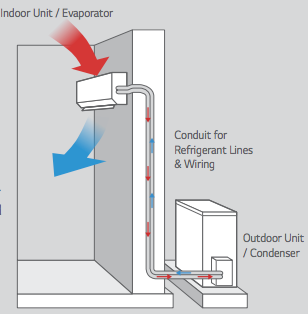
Do we walk into our homes and flip one switch and turn on every light in the entire house?
No. of course not!
Yet, that’s exactly what we do with the most expensive appliance in our home! You turn on the cooling or heating system and every room in the house is conditioned to the same temperature whether we are occupying these rooms are not.
Now, you can independently and efficiently control the temperature in each room in your home with ductless air conditioners and heat pumps. This ability to independently control the temperature in every room of your home is known as “zoning”.
In addition to the extreme operating efficiencies of ductless mini-splits, the ability to dramatically reduce the operating time of each system is a major factor in the overall utility savings.
If you have a third or fourth unused bedroom, simply set the temperature up to about 82° in those rooms and drop the operating time of the ductless system by up to 80%, directly lowering your utility costs, as well as reducing wear and tear on the system.
This means that each room has its own independent temperature remote control device that mounts on a base attached to a wall. Not only is the operating cost-per-hour up to 80% less, you can adjust the temperature in the cooling or heating mode when you are not actually occupying that room.
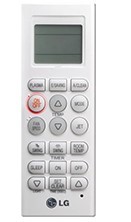 If you’re like me, and you prefer a cooler setting at night in your bedroom, you can now cool your master bedroom to the perfect sleeping temperature without wasting utilities inefficiently over-cooling the entire home.
If you’re like me, and you prefer a cooler setting at night in your bedroom, you can now cool your master bedroom to the perfect sleeping temperature without wasting utilities inefficiently over-cooling the entire home.
Mini split noise level – What is the quietest mini-split system?
Ductless air conditioners as a whole, are, inarguably, the quietest air conditioners you can buy. The indoor sections are nearly inaudible. The sound rating levels, (decibel levels) are rated and tested by the various manufacturers. The lowest claimed sound levels for the indoor sections are about 19 dB.
To put that in perspective, most refrigerators operate at about 40-50 DB and a human whisper is about 30 dB or so, while a normal human breath is about 20 dB.
I have a Mitsubishi ductless air conditioner in my home office and the only way I can tell if it’s running is to walk up and put my hand in front of it to feel the airflow. Even from just a few feet away, it is difficult to determine if it is actually running as the noise level is almost entirely negligible.
How much does it cost to buy and install a ductless mini-split?
The average equipment cost for a single room or “zone” will be between $700 (for lower quality or unproven brands with the required installation accessories) and $2000 or a bit more (for high-end, feature packed units from top quality brands like Mitsubishi or Daikin).
One of the main reasons to choose a mini-split is the savings on labor costs from not having to install ducts. That typically involves tearing ceilings open, running ducts, and making repairs, including repainting. Unless you’ve already gutted the place, that’s not a realistic option.
The labor involved will depend on how and where you want to install the unit. The distance between the indoor and outdoor units is a factor, as longer distances require longer refrigerant lines and conduit.
Your purchase cost will be impacted by efficiency, as well. The SEER measure is a major metric in the air conditioning industry. It stands for Seasonal Energy Efficiency Rating, and ranges between 13 and 21, with higher end units going into the 30s or even 40s. You might think of a higher SEER rating as being similar to a vehicle getting better MPG.
So, in short, cost is extremely hard to determine without knowing more specifics. By way of offering the best answer possible, let us say this:
A single zone system will probably require $1100-$1400 worth of labor on top of the equipment cost. That covers the installation and the electrical service, as the outdoor unit requires a dedicated circuit of 120v (for small systems) to 220v (for systems over 12,000 BTU).
A 3-zone system (one that can heat and cool three separate zones or rooms) might raise your labor costs to $1200-$2500, as it requires 4-5 more hours of work to install the additional (wall mounted) indoor units.
Keep in mind that this labor cost is still much less than what you’d pay for a ducted system. Your equipment costs can only be determined by your needs.
Is a ductless heat pump AC system more energy efficient?
In short, yes, and extremely so. The most efficient traditional (and expensive) ducted central air conditioners currently on the market have a SEER rating of 26. The most efficient mini-splits on the market have SEER ratings as high as 42, with many in the high 30s.
Without bogging you down in the math, we’ll offer a very simple calculation. A mini-split with a high SEER rating might cost $0.04 per hour to operate. That number is a bit arbitrary, but it’s achievable with a SEER rating of 26 or higher in any part of the USA that isn’t dramatically overcharging you on your electric bill.
But, for the sake of argument, we’ll raise it to $0.05. A nickel an hour. Clean and easy.
There are thousands of active HVAC systems in older homes around the country, systems that were top of the line in the mid-2000s, that have a SEER rating of 10 or so, and cost $0.55/hour to run.
That’s a real number, and a likely one.
Translation? If you ran a mini-split 10 hours a day for 30 days, your utility cost for that climate control would be $15.00. Fifteen bucks for the entire month.
If you ran your central air unit for that same 10 hours a day for 30 days, your utility bill would be $165 or more – and we’re willing to bet you’ve seen numbers that high if you’re running older air conditioners.
Now – let’s be fair. The central air is cooling the whole house, not just one room. But let’s say you installed a multi-zone ductless mini-split system that had FIVE separate indoor units, a really massive system, covering everywhere.
That’s still only $75.00 a month in utility costs.
Put simply, using a 5 zone mini-split system, still costs less than half what operating that outdated central air system does.
Oh – and it’s greener, too.
Here’s an excerpt from Forbes:
“Each of the zones will have its own thermostat so only the occupied rooms can be conditioned, saving energy and money. Some units are self-correcting, so they can increase or decrease output depending on the set temperature.
These systems are also small in size, cost less to install than traditional HVAC systems, and use a fraction of the energy, substantially reducing utility bills. ENERGY STAR qualified systems can reduce cooling and heating costs by 30%. Newer models are continuously coming on the market that are increasingly efficient”.
How do ductless air conditioners work?
A mini-split operates on the same basic principle as any other air conditioner or heat pump. Like a central air system, it uses an indoor unit and an outdoor unit. However, it dispenses with the cumbersome ductwork; cuts out the middleman, you might say.
Typical installation
One of the best features of a ductless system is the ease of installation. A qualified contractor can usually install it in about a day, sometimes less. (Do-it-Yourselfers - Learn how to select a qualified contractor to install the system you select).
There is little to no ductwork required so you don't have to worry about a disorder in your home interrupting your life or costly remodeling expenses.
The sleek, ductless indoor unit mounts discreetly within the space, and a pair of small refrigerant lines plus power and control wiring, connect it to the outdoor unit through a small three-inch opening in the wall.
The outdoor condensing unit is typically shaped like a medium size suitcase, as opposed to a traditional outdoor unit being shaped more like a large trash can.
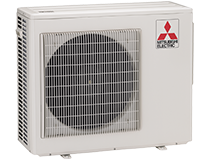
Mitsubishi Outdoor Section

LG Indoor wall mounted unit
So just like a traditional ducted system, there is an outdoor condensing unit and indoor section to supply air into the chosen conditioned space.
But that’s where the similarity ends.
Because of this, they’re easier to install. They can be wall-mounted unobtrusively, high in a space, installed in a ceiling or beneath a floor with a short duct run exclusive to its needs, or even recessed and flush-mounted in your ceiling.
A pair of refrigerant lines, a condensate drain line (to remove the water that accumulates during the humidity removal process), and some wiring is all that connects the indoor and outdoor units.
Instead of ungainly ductwork, all the temperature exchanges are done through a small three-inch hole in your wall (which is hidden from view entirely as it is located directly behind the wall mounted indoor unit) through which these lines are run.
Here’s a diagram that visually outlines how a standard installation would look:
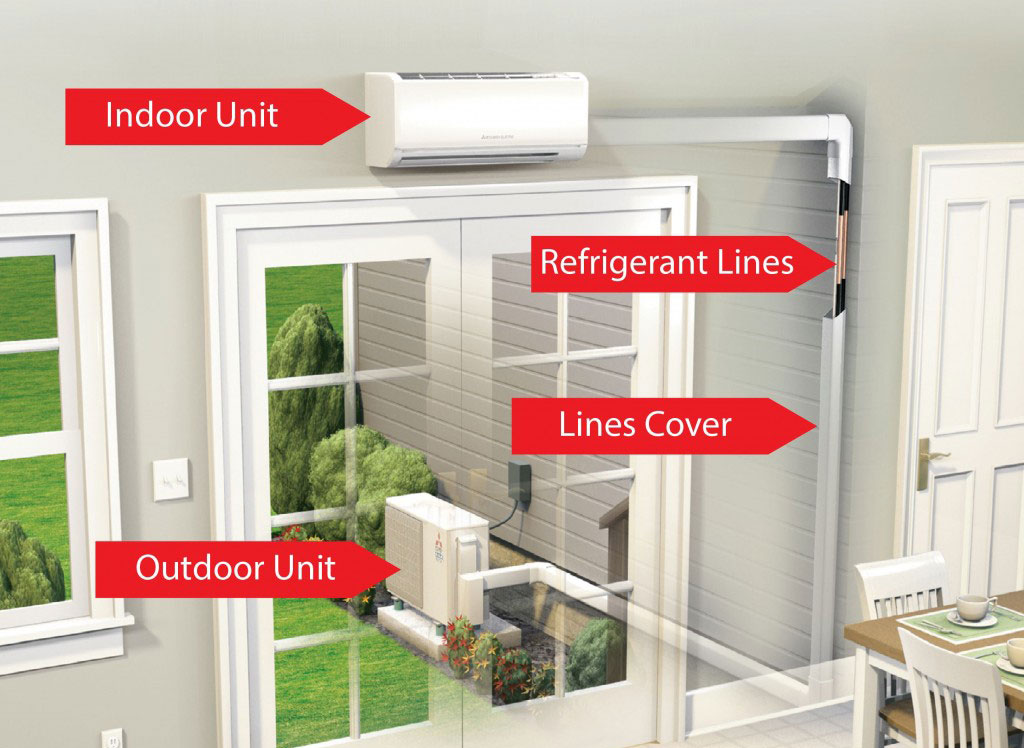
Are there different types of ductless AC indoor units?
The wall mounted is by far, the most common and popular indoor section used with a ductless mini split.
Here is an image showing the common style options for the indoor unit available from most of the popular brands:
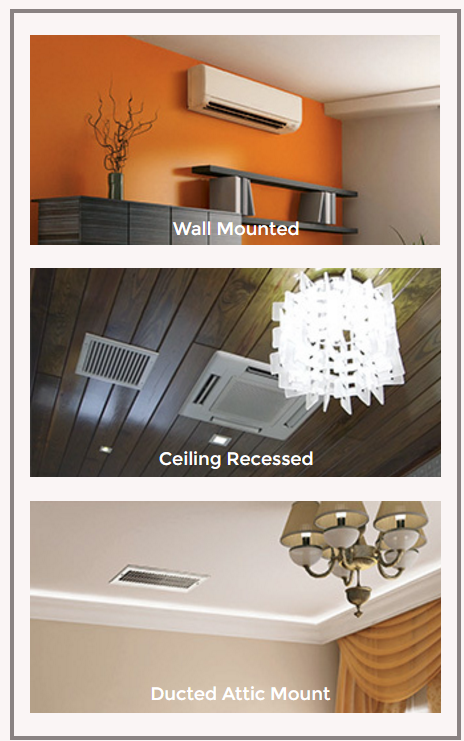
Here are the features and benefits of the various indoor unit options.
High Wall mounted –
These are the easiest to install for the reasons listed earlier in this article. The only real drawback for some clients is the aesthetics of the wall mounted indoor unit can be off-putting to some. My take on this is once it’s installed you will forget it’s even there, most of the time.
However, if the aesthetics are a concern there are 2 other options that will negate this issue.
Low sidewall (floor mounted) –
This style of indoor unit is intended to be installed on the lower sidewall, instead of the high sidewall. The low sidewall mounted indoor unit make it a bit more unobtrusive in the room while still maintaining the ease of installation using only a completely hidden 3” inch hole in the wall directly behind it for the piping, drain, and electrical wiring.
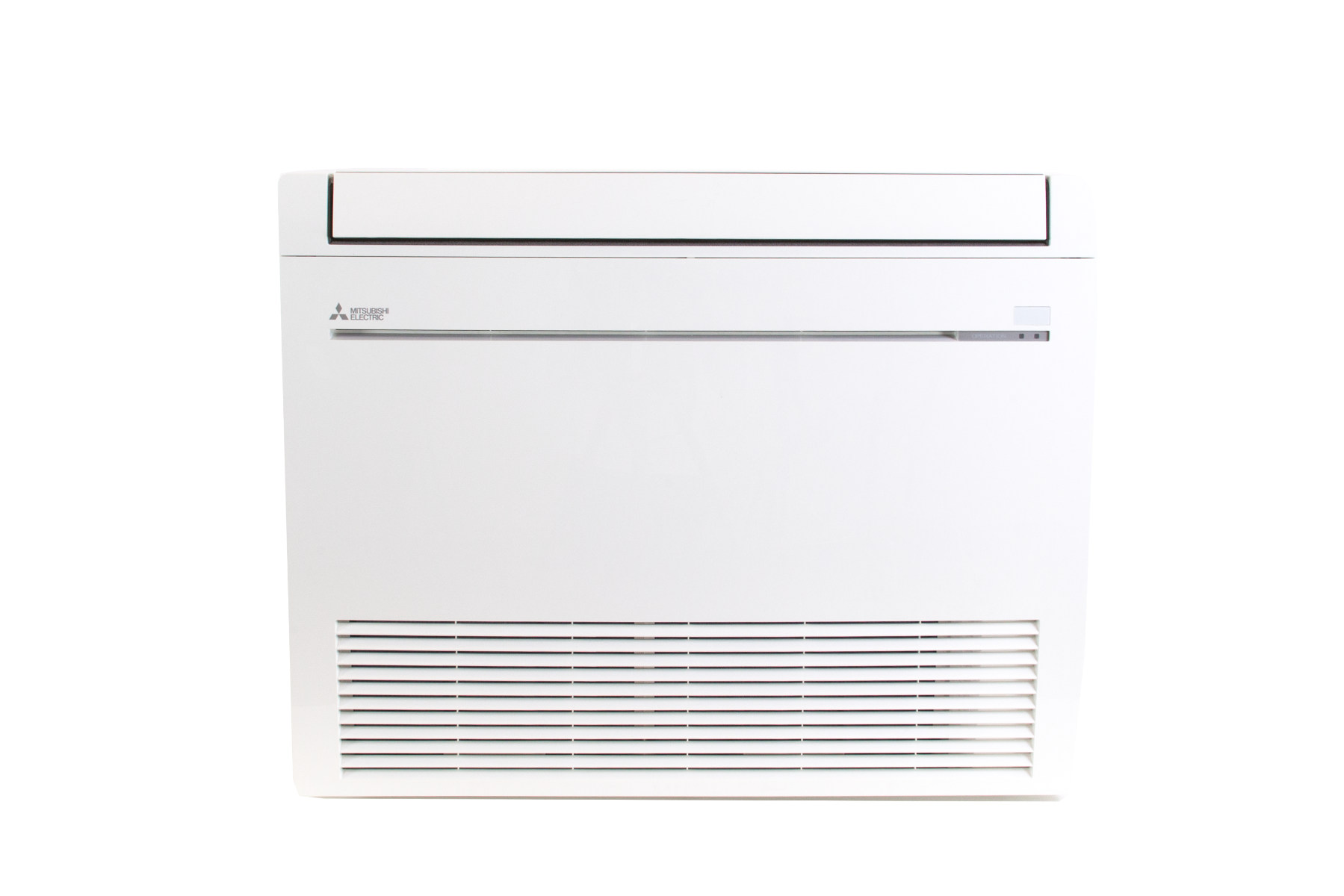
Ceiling recessed –
The only thing exposed within the room is the ceiling mounted grill where the air is supplied and returned within the space. The ceiling recessed cooling section (ceiling cassette) itself is mounted above the ceiling in the attic space or in the space above the ceiling, entirely out of view.
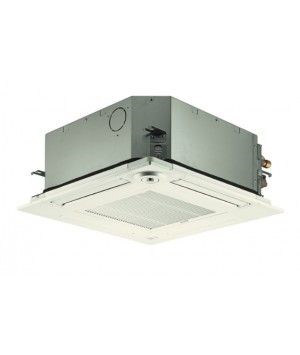
Horizontal Ducted attic mount –
Of course, this style of indoor unit violates the whole “ductless” concept but for a very good reason; the only thing exposed within the space is a traditional “supply” grill {where the conditioned air is delivered to the space) and a “return” grill (where the air is pulled and then cooled or heated).
The ducted attic mount unitis just as the name implies installed above the ceiling completely out of view.
These adjoining rooms are supplied with conditioned air from the one attic-installed indoor section using traditional small ducts (6-7” each).
Ducted attic-mount indoor units are typically used when there are a number of secondary rooms that only require a small level of heating and/or cooling. (1/2 baths, closets, small pantries, etc.)
The ducted attic-mount indoor units do require more installation time and a limited amount of ducting so they are not quite as convenient when it comes to installation.
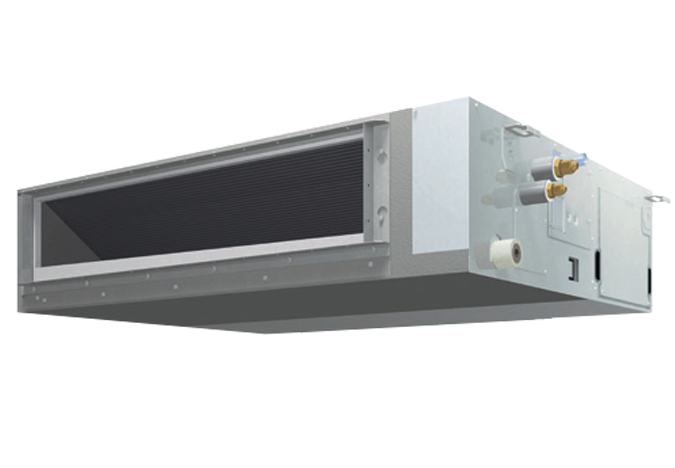
Do I need a mini split for every room?
Every ductless mini split consists of an indoor unit and an outdoor unit. The indoor unit contains a fan and evaporator coil, and is capable of cooling one room or “zone,” depending on your needs. In summary, yes, if you want to cool multiple spaces, you’ll need more than one indoor unit.
However – and we’ve found that many consumers don’t know this – you can pair a single outdoor/condenser unit with multiple indoor units. A multi-zone system can be made that connects the outdoor unit to as many as 8 indoor units – meaning you can have all the convenience of central air without calling in a demolition crew.
How many ductless units do I need?
As stated above, the number of indoor units you require is exactly equal to the number of rooms you want to heat and cool. If you have 3 bedrooms, a living room, an eat-in kitchen, and a finished basement, you may want a multi-zone system with 6 indoor units.
Does a mini split cool the whole house?
In order to cool an entire home, you’ll want to purchase a multi-zone mini split ductless air conditioning system.
Can ductless AC cool multiple rooms?
An HVAC contractor will help you determine the most efficient way to cool your home, but the short answer is yes, a mini split system can be chosen to cool multiple rooms.
How many BTU’s do I need? (Cooling and heating)
While there are tools online which help you calculate the BTU cooling needs of your home, they are designed to be used by professionals. Essentially, they’re a rough estimate.
For shorthand, though, it’s worth mentioning that a 12,000 BTU air conditioner (a standard and common size) can cool up to 550 square feet, which is the size of an average single bedroom apartment in the city, or a spacious 2-car garage.
What you want to do is ask your installer to do a proper load calculation to determine precisely what size mini split you need.
Or, here is our quick, simple to use cooling and heating system sizing calculator.
Does a ductless mini split heat well in cold climates?
Yes. Technology has caught up. First off, in case this hasn’t been made clear enough, mini splits also heat spaces. They’re not just air conditioners, they’re heat pumps. So when you’re installing them, keep in mind that they’ll do double-duty and serve all year long.
It used to be that heat pumps in general didn’t work so well in extremely cold climates, but manufacturers have caught up with that problem.
Now, this is important: Not all mini splits work great in cold weather.
Make sure that if that’s a concern for you, you purchase the right unit. Mitsubishi, for instance, has special ductless heat pump systems that feature a proprietary “hyper heat” technology that can continue to generate heat in temperatures where other heat pumps might struggle (below 5 degrees Fahrenheit).
Most HVAC contractors will be familiar with the needs of the areas they serve, but it’s important to ask questions like that when buying a mini split system.
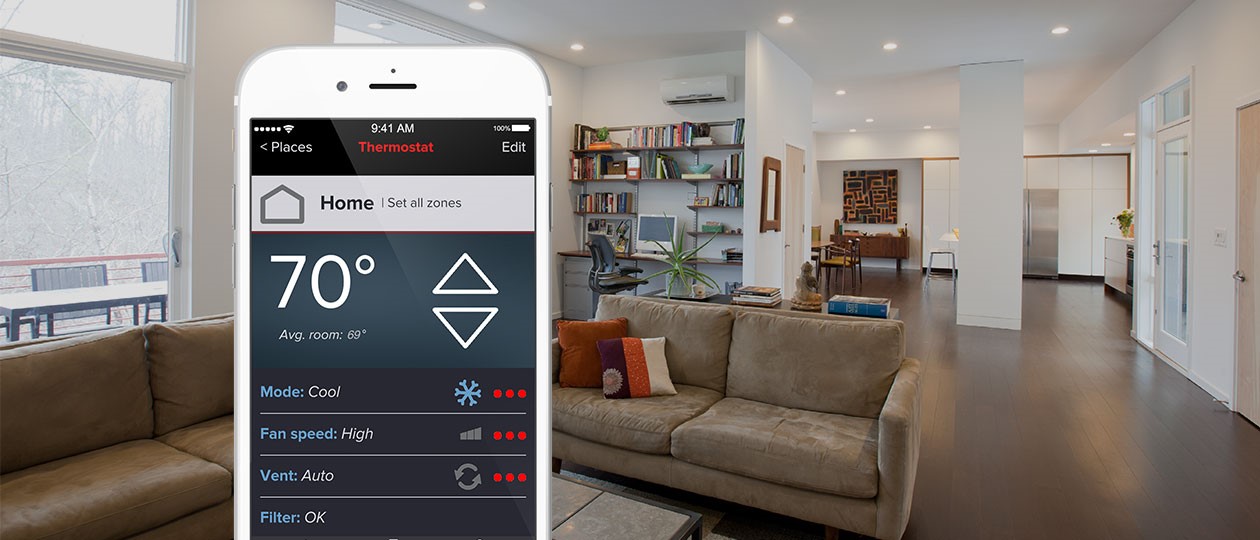
Ductless Mini Split AC Systems the Heating and Cooling Wave of the Future
Mini split systems are gaining popularity in the United States because of their unbeatable combination of flexibility, ease of installation, efficiency, and affordability.
Over the last few years, we’ve seen exponential growth in mini split interest and installations. That is to be expected, because honestly, they are extremely versatile, and each year, they’re becoming more and more efficient and affordable.
They provide immediate (and attractive) heating and cooling solutions in situations where central air is impractical and window units aren’t desirable.
So, there you have it. Mini Splits 101 has concluded.
This guide should have prepared you to boldly go and find the mini split that is right for your home or business. We will be unpacking the information in this article in other posts in even greater detail. As always, if you find yourself with more questions, we are always right here with the answers you need.
To Wrap it Up
With mini-split systems, you'll find options ranging from the highly efficient Daikin models to Goodman's budget-friendly units. Features like smart controls, ENERGY STAR certification, and generous warranties add layers of value. Whether you need a single-zone system for a small apartment or a 4-zone powerhouse for a larger space, your choices are abundant.

 and now, NASCAR Racing Sponsor
and now, NASCAR Racing Sponsor








